When we think about home design, upstairs hallways often get overlooked and treated as mere transitional spaces. But we’re here to change that perspective entirely. These connecting corridors hold incredible potential to become stunning focal points that tie your home’s upper level together beautifully.
We’ve discovered that transforming an upstairs hallway doesn’t require a massive budget or extensive renovation. With the right design strategies, lighting choices, and creative touches, you can turn that narrow passage into a space that guests will remember long after they leave.
From gallery walls that tell your family’s story to clever storage answers that maximize every inch, we’ll show you how to make your upstairs hallway work harder and look better. Whether you’re dealing with a long narrow corridor or a compact landing area, these ideas will help you create a space that’s both functional and fabulous.
Create A Gallery Wall With Family Photos And Artwork
Gallery walls transform bare upstairs hallway walls into meaningful displays that tell your family’s story. We’ve found that these collections work particularly well in long corridors where you can create an extended visual journey.
Choose A Cohesive Color Palette For Frames
Color coordination creates visual harmony that prevents your gallery wall from looking chaotic. We recommend selecting 2-3 frame colors that complement your hallway’s existing decor, such as matching whites and natural woods or combining black frames with metallics like gold and silver.
Neutral frame palettes work best for upstairs hallways since they won’t compete with the artwork inside. Consider using white frames throughout for a clean contemporary look, or mix warm wood tones like oak and walnut for a more traditional aesthetic.
Temperature consistency matters when selecting frame colors. We suggest sticking to either warm tones (golds, browns, coppers) or cool tones (silvers, blacks, grays) rather than mixing both palettes together.
Mix Different Frame Sizes For Visual Interest
Size variation prevents your gallery wall from appearing too uniform and creates ever-changing visual movement. We typically use a combination of large statement pieces (16×20 inches or larger), medium prints (8×10 to 11×14 inches), and smaller accent frames (5×7 inches) to achieve balanced proportions.
Odd numbers of frames work better than even arrangements for creating natural flow. Start with one large anchor piece and build around it using 3, 5, or 7 total frames depending on your hallway’s length and wall space.
Spacing between frames should remain consistent at 2-3 inches regardless of frame sizes. We recommend laying out your arrangement on the floor first to test different combinations before hanging anything on the wall.
Include Personal Mementos And Travel Souvenirs
Personal touches make your upstairs hallway gallery uniquely yours and create conversation starters for guests. We suggest incorporating items like vintage postcards from family trips, children’s artwork, wedding invitations, or pressed flowers from special occasions alongside traditional photographs.
Shadow boxes work perfectly for displaying three dimensional keepsakes like ticket stubs, small sculptures, or jewelry pieces. Mix these deeper frames with standard photo frames to add textural depth to your hallway display.
Document your family’s milestones through rotating seasonal displays. We recommend swapping out 2-3 pieces quarterly with new vacation photos, school pictures, or holiday memories to keep your gallery wall fresh and current.
Install Statement Lighting To Transform The Space
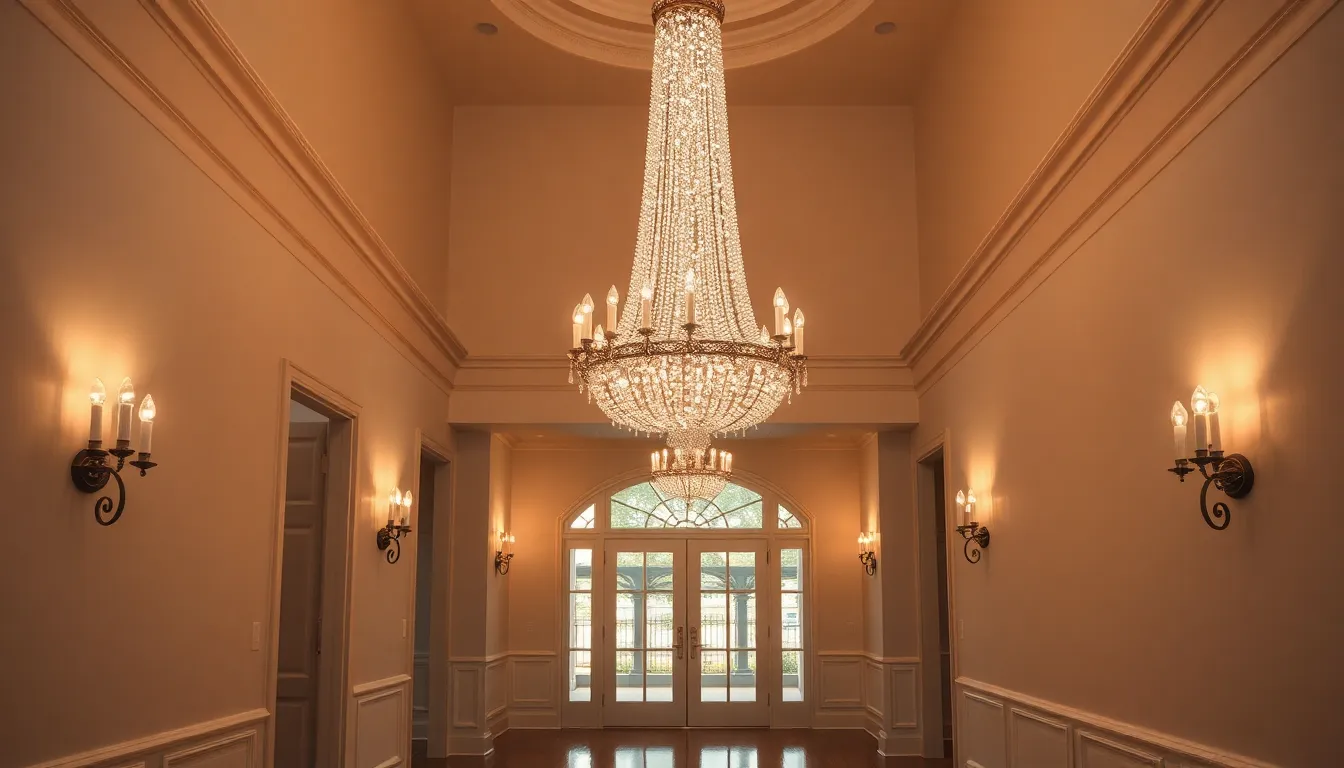
Statement lighting serves as one of the most effective ways to elevate your upstairs hallway from a simple passageway into a stunning architectural feature. The right lighting fixture can instantly create visual interest and establish the mood for your entire upper level.
Add A Dramatic Chandelier As A Focal Point
Chandeliers work exceptionally well in upstairs hallways with high ceilings, creating an immediate sense of luxury and sophistication. We recommend selecting a chandelier that’s proportional to your hallway’s dimensions to avoid overwhelming the space. Crystal chandeliers add timeless elegance, while modern geometric designs bring contemporary flair to traditional homes.
Positioning your chandelier strategically ensures maximum visual impact without obstructing foot traffic. We suggest centering it in the longest section of your hallway or above a central landing area. Large hallways can accommodate more elaborate chandeliers, making them perfect showcases for statement pieces that guests will remember long after their visit.
Use Wall Sconces For Ambient Lighting
Wall sconces provide versatile ambient lighting that creates warmth and visual continuity throughout your upstairs hallway. We find that placing sconces at regular intervals along the walls generates an even, welcoming glow that’s both functional and beautiful. Traditional brass sconces complement classic home styles, while sleek modern fixtures enhance contemporary designs.
Strategic placement of wall sconces eliminates harsh shadows and creates layers of light that make your hallway feel more spacious. We recommend mounting them at eye level, approximately 60 to 66 inches from the floor, to achieve optimal lighting distribution. Battery operated sconces offer installation flexibility in hallways where electrical work might be challenging.
Consider Pendant Lights For Modern Appeal
Pendant lights deliver modern sophistication to upstairs hallways while offering incredible versatility in design and placement. We love using multiple pendant lights spaced evenly apart to create rhythm and visual flow in long corridors. Industrial pendant lights add urban charm, while glass globe pendants provide clean, minimalist appeal.
Multiple pendant configurations work particularly well in hallways that connect several bedrooms or lead to stairways. We suggest varying the heights slightly to create visual interest without sacrificing functionality. Single large pendants make bold statements in shorter hallways, while clusters of smaller pendants can define exact zones within longer spaces.
Maximize Storage With Built-In Solutions
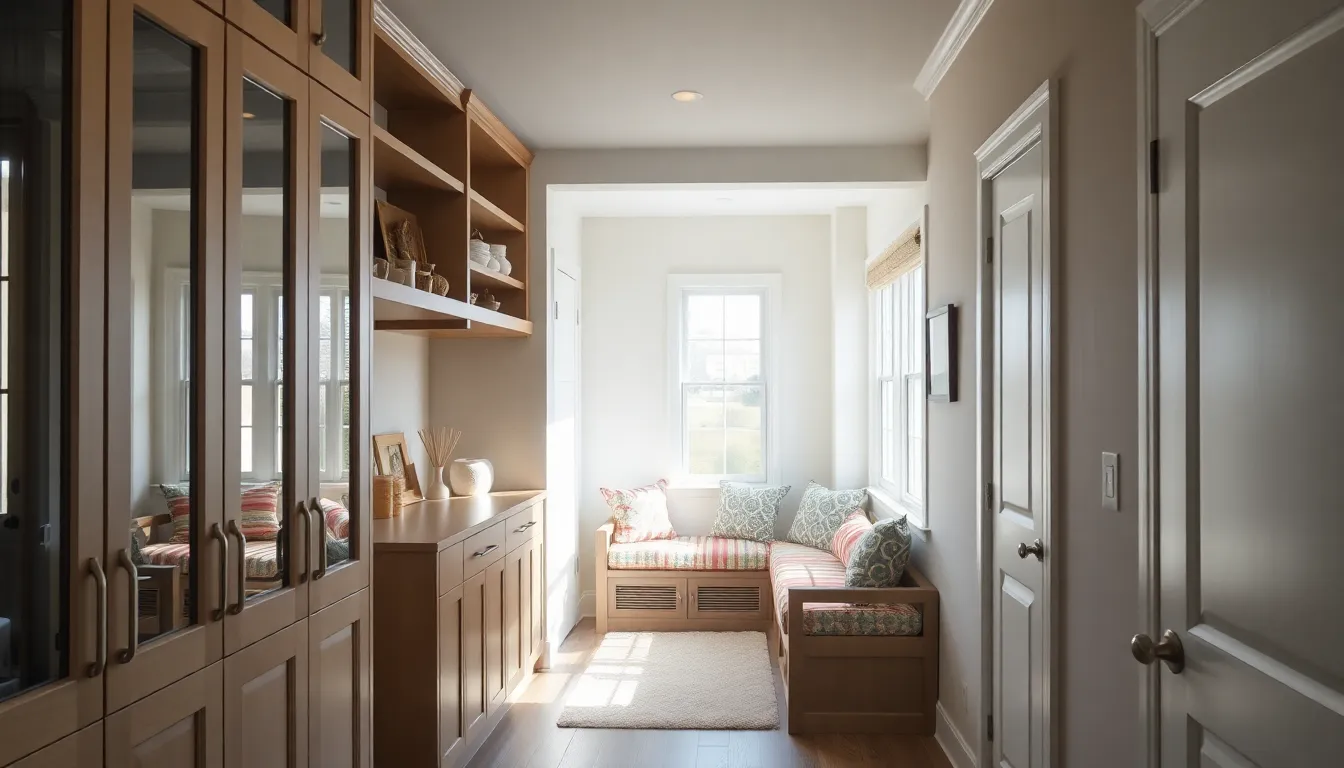
Built-in storage answers transform unused wall space into valuable organizational assets that enhance both function and flow in your upstairs hallway. We recommend custom cabinetry that fits seamlessly into alcoves or awkward corners, providing concealed storage for linens, toys, books, and seasonal items while maintaining a clean, uncluttered appearance.
Design Custom Linen Closets With Glass Doors
Custom linen closets with glass doors offer the perfect blend of utility and visual appeal for your upstairs hallway storage needs. Glass doors prevent the closed-off feeling that solid doors create while keeping your contents organized and easily visible. We’ve found that this design choice encourages better organization habits since everything remains in plain sight.
The transparency of glass doors also helps reflect natural light throughout the hallway, creating a brighter and more open atmosphere. These closets work particularly well for frequently accessed items like towels, bedding, and bathroom supplies. Installing interior lighting within the closet further enhances visibility and adds a sophisticated touch to your hallway design.
Add Floating Shelves For Display And Function
Floating shelves provide versatile storage options that adapt to your changing needs while maintaining a minimalist aesthetic. We recommend choosing shelves in materials and finishes that complement your existing hallway decor, whether that’s warm wood tones, sleek metal, or painted surfaces.
These shelves serve dual purposes by displaying family photos, artwork, or decorative objects while keeping practical items like books, storage baskets, or bins within easy reach. The wall-mounted design eliminates floor clutter and creates the illusion of more space in narrow hallways. Consider installing shelves at varying heights to create visual interest and accommodate different sized items.
Install Window Seats With Hidden Storage
Window seats with hidden storage maximize underutilized nooks in your upstairs hallway while creating inviting spaces for relaxation. The lift-up seat cushion reveals a spacious compartment perfect for storing blankets, toys, out-of-season clothing, or extra linens that you don’t need daily access to.
This built-in solution takes advantage of natural light from windows while providing additional seating for reading or simply enjoying the view. We suggest adding comfortable cushions and throw pillows to make the space more inviting. The storage compartment keeps items organized and out of sight, contributing to the clean, streamlined look that makes hallways feel more spacious and welcoming.
Incorporate Bold Wallpaper Or Paint Colors
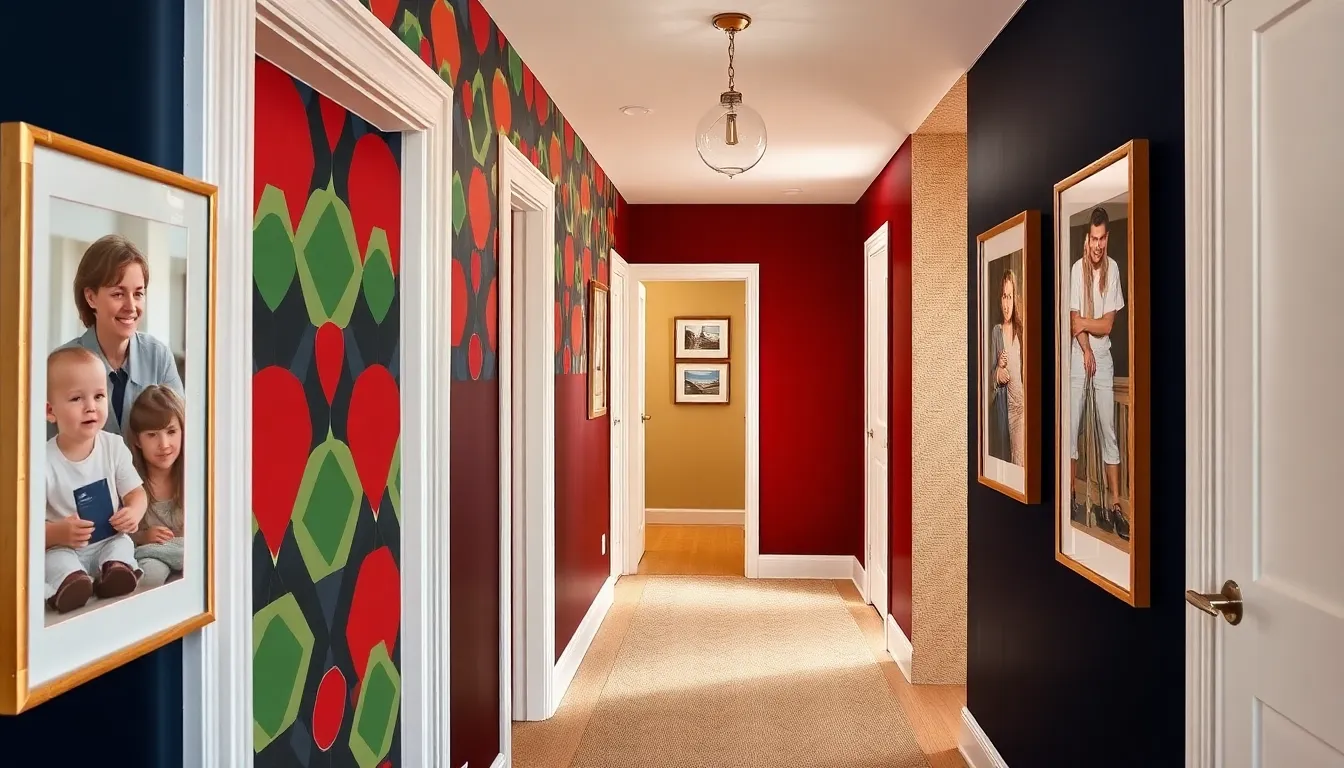
Transform your upstairs hallway into a captivating focal point by embracing bold wallpaper patterns or vibrant paint colors. These design choices can instantly elevate what’s often considered a transitional space into a memorable part of your home.
Choose Geometric Patterns For Contemporary Style
Geometric patterns like chevrons or hexagons bring modern sophistication to upstairs hallway design. We recommend selecting patterns that complement your home’s existing décor while creating visual movement throughout the corridor. Large scale geometric wallpapers work exceptionally well in longer hallways as they create rhythm and flow that draws the eye forward.
Contemporary geometric designs can also make narrow spaces appear wider through strategic pattern placement. Consider alternating wall treatments where one wall features bold geometric wallpaper while the opposite wall maintains a complementary solid color. This approach prevents overwhelming the space while maintaining that modern aesthetic you’re seeking.
Use Dark Colors To Create Intimate Atmosphere
Dark paint colors transform upstairs hallways into cozy retreats that feel luxurious and inviting. Rich navy blue or deep forest green creates an intimate atmosphere that makes your hallway feel like a sophisticated gallery space. We’ve found that darker hues work particularly well in hallways with adequate natural light or strategic artificial lighting.
Deep colors also provide an excellent backdrop for artwork and family photos along your hallway walls. The contrast between light colored frames and dark walls creates dramatic visual impact that enhances your displayed pieces. Remember that proper lighting becomes even more crucial when working with darker color palettes to maintain functionality and safety.
Add Textured Wallpaper For Depth And Interest
Textured wallpaper introduces tactile elements that create visual depth and sophisticated appeal in upstairs hallways. Grasscloth textures or subtle raised patterns add dimension without overwhelming smaller spaces. We suggest choosing textures that catch and reflect light differently throughout the day to create an ever changing visual experience.
Textured surfaces work especially well in hallways because they invite closer inspection as people move through the space. Consider textured wallpaper on a single accent wall to create a focal point while maintaining balance with smoother surfaces on adjacent walls. This approach provides the sensory interest you want without making the hallway feel too busy or cluttered.
Add Functional Seating Areas
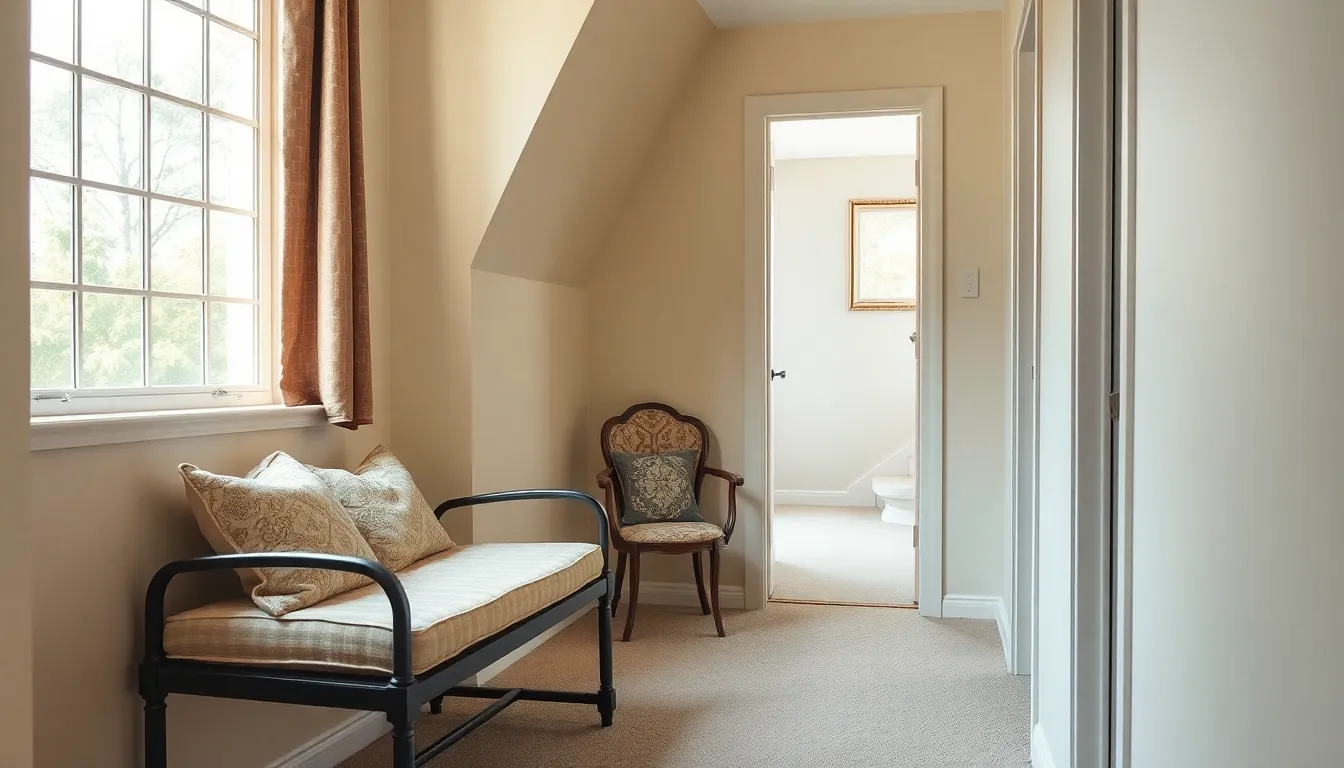
Upstairs hallways offer unexpected opportunities to create cozy seating spots that combine comfort with style. We’ll explore how strategic seating placement can transform these transitional spaces into meaningful areas for relaxation and daily use.
Place A Bench Under Windows For Reading Nooks
Position a simple bench beneath hallway windows to create an instant reading retreat. Natural light streaming through the glass provides perfect illumination for books and magazines while the elevated placement offers scenic views of your outdoor space. We recommend choosing benches with clean lines that won’t overwhelm narrow corridors.
Select cushioned benches for extended comfort during longer reading sessions. Upholstered tops in durable fabrics like linen or cotton blends withstand regular use while adding softness to hard surfaces. Storage benches work especially well here since they provide hidden space for books, throws, and seasonal items.
Enhance the reading nook with practical accessories that support daily use. Small side tables or floating shelves nearby hold coffee cups, reading glasses, and current book selections. We’ve found that battery operated reading lights clipped to window frames extend reading time into evening hours.
Install Built-In Window Seats With Cushions
Built-in window seats create permanent seating answers that maximize every inch of available space. Custom construction allows for perfect fitting around window frames and architectural details while providing substantial storage underneath. These installations work particularly well in hallways with deep window alcoves or bay windows.
Design built-in seats with lift-up cushions to reveal hidden storage compartments below. This dual purpose approach keeps linens, out of season clothing, or children’s toys organized and accessible. We suggest installing soft-close hinges to prevent slamming and ensure quiet operation during early morning or late night use.
Choose cushion fabrics that complement your hallway’s existing color palette and lighting conditions. Weather resistant materials like Sunbrella or indoor/outdoor fabrics handle sunlight exposure and occasional spills. Removable cushion covers simplify cleaning and allow for seasonal updates to keep the space feeling fresh.
Use Vintage Chairs As Decorative Elements
Incorporate vintage chairs as sculptural elements that add character without requiring functional use. Antique wooden chairs, mid-century modern pieces, or ornate Victorian styles serve as conversation starters while filling empty corners or wall spaces. We position these chairs at angles to create visual interest and prevent the hallway from feeling like a museum display.
Mix different chair styles and periods to create an eclectic, collected-over-time appearance. Combining a rustic farmhouse chair with a sleek mid-century piece adds depth and personality to neutral hallway backgrounds. Paint treatments can unify disparate styles while maintaining each piece’s unique character.
Use vintage chairs as functional accent pieces for temporary seating needs. Guests appreciate having a spot to sit while putting on shoes or waiting, and the vintage character adds warmth to what could otherwise feel like sterile transitional space. We recommend securing valuable pieces to walls in high-traffic areas to prevent accidental damage.
Design A Runner Or Area Rug Strategy
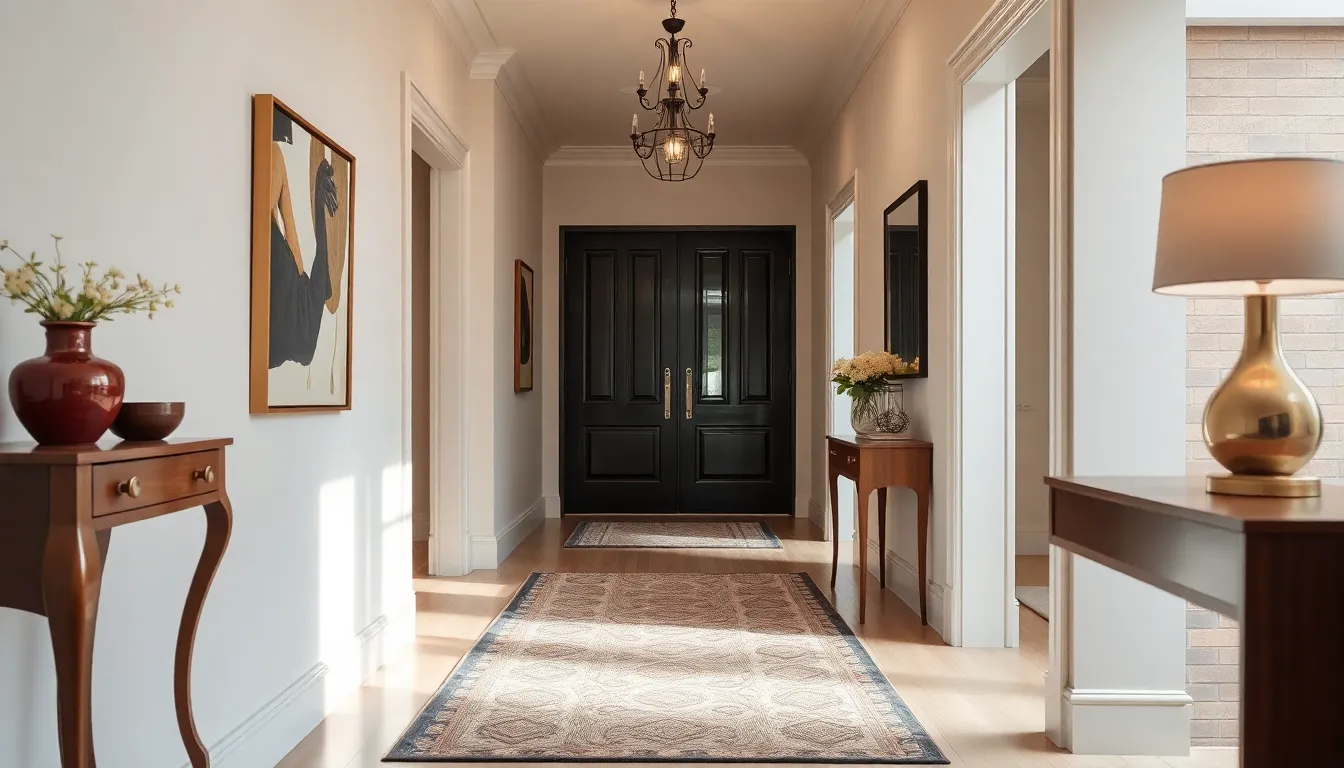
Establishing the right foundation for your upstairs hallway starts with a well-planned runner or area rug strategy. We’ll guide you through selecting the perfect rug placement that directs traffic flow toward bedrooms or loft areas while avoiding narrow turns and bottlenecks.
Select Patterns That Complement Your Home’s Style
Match your existing decor by choosing patterns that align with your home’s overall aesthetic, whether it’s modern, traditional, or bohemian. Bold geometric patterns work exceptionally well in contemporary spaces, creating visual movement that makes narrow hallways appear wider. Neutral patterns blend seamlessly into the background, allowing other design elements like artwork or lighting to take center stage. Traditional homes benefit from classic motifs such as florals, paisleys, or damask designs that echo the timeless elegance found throughout the space. Bohemian styles embrace eclectic patterns like kilim designs, tribal prints, or vintage inspired motifs that add character and warmth to upstairs corridors.
Choose Durable Materials For High-Traffic Areas
Wool runners offer exceptional durability and natural stain resistance, making them ideal for busy upstairs hallways that connect multiple bedrooms. Sisal and jute provide hard wearing natural fibers that withstand heavy foot traffic while adding organic texture to your design scheme. Synthetic materials like polypropylene and nylon deliver easy maintenance benefits with built in stain resistant treatments that handle spills and daily wear. Flatweave constructions prove more practical than high pile options since they’re easier to vacuum and less likely to trap dirt in upstairs areas. Machine washable rugs offer the ultimate convenience for families with children or pets who frequently use the hallway.
Layer Rugs For Added Texture And Warmth
Create visual depth by placing a smaller decorative rug over a larger, more practical base runner to achieve the layered look that’s currently trending in interior design. Combining different textures like a smooth flatweave base with a plush accent rug adds tactile interest while making the hallway feel cozier and more inviting. Neutral base layers work best when topped with patterned or colorful accent pieces that can be easily changed with seasons or design updates. Strategic layering also allows you to experiment with different sizes and shapes, such as placing a round rug over a rectangular runner at key transition points. This technique helps define exact zones within longer hallways while adding warmth and comfort underfoot.
Create Architectural Interest With Molding And Trim
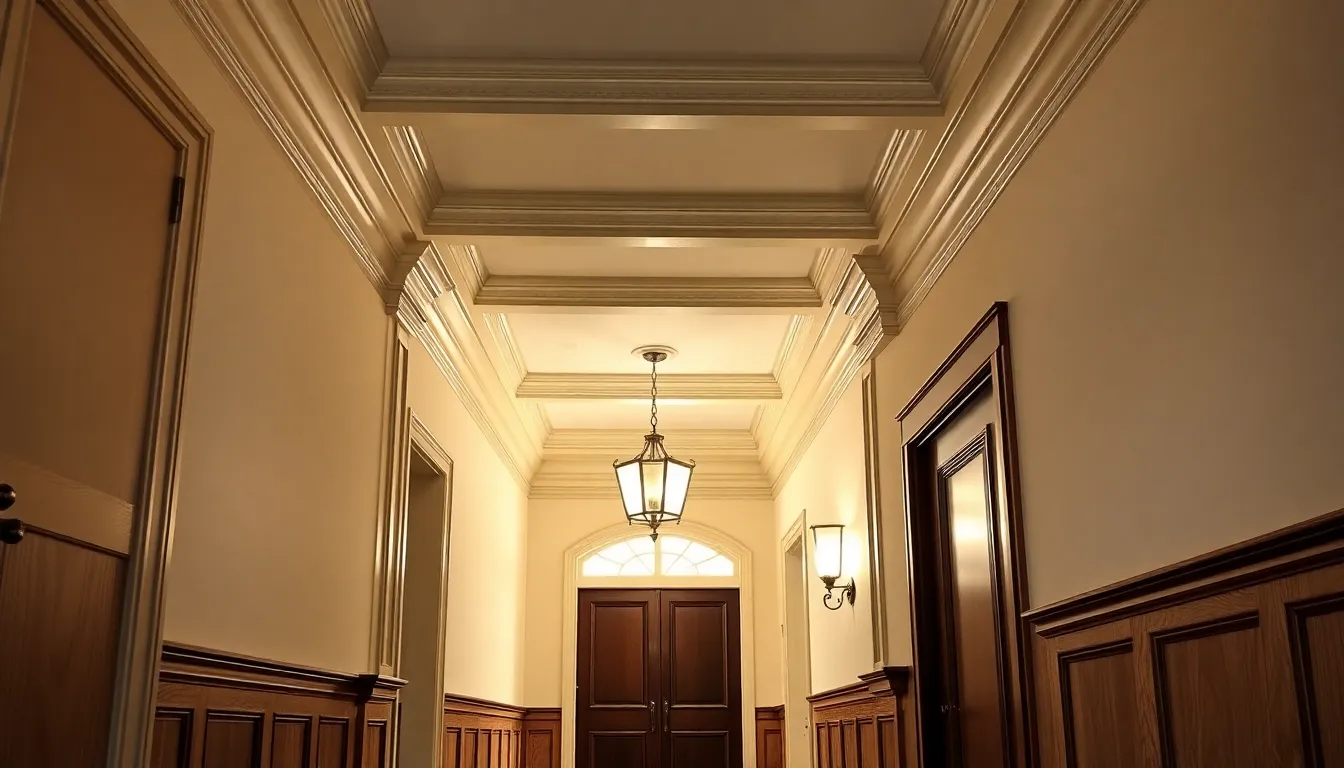
Architectural details transform ordinary upstairs hallways into sophisticated spaces that reflect your home’s character. Molding and trim work elevate these transitional areas beyond basic functionality into stunning design statements.
Add Wainscoting For Classic Elegance
Wainscoting introduces timeless sophistication to upstairs hallways by paneling the lower portion of walls with wood or composite materials. Classic beadboard wainscoting creates vertical lines that draw the eye upward, making standard height ceilings appear taller while adding texture and visual interest.
Traditional raised panel wainscoting works beautifully in formal homes, providing depth and shadow play that changes throughout the day as natural light shifts. Flat panel wainscoting offers a cleaner look for contemporary spaces while still delivering the protective benefits and architectural charm.
Installing wainscoting typically covers the lower 32 to 36 inches of wall space, creating a natural division that protects high traffic areas from scuffs and damage. Chair rail molding caps the wainscoting installation, providing a finished edge that ties the entire design together.
Install Crown Molding For Finished Look
Crown molding creates a polished transition between walls and ceilings that instantly elevates any upstairs hallway design. Installing crown molding adds a decorative touch to ceiling edges while creating visual continuity throughout your home’s upper level.
Simple cove molding works well in casual settings, while elaborate crown profiles with multiple layers suit more formal architectural styles. Dentil crown molding features small rectangular blocks that create shadow lines and classical detail reminiscent of Greek and Roman architecture.
Crown molding installation requires precise measurements and careful attention to corner joints, but the finished result adds important perceived value to your home. Painting crown molding in crisp white creates contrast against colored walls, while matching the wall color creates a more subtle, cohesive appearance.
Use Board And Batten For Farmhouse Style
Board and batten installation creates rustic charm in upstairs hallways through vertical boards separated by narrow horizontal battens. This traditional siding technique translates beautifully to interior spaces, adding farmhouse character and visual texture.
Spacing boards 12 to 16 inches apart creates balanced proportions that work well in most hallway widths. Installing board and batten from floor to ceiling maximizes impact, while partial height installations paired with paint or wallpaper above offer design flexibility.
Wide boards create bold statements suitable for larger hallways, while narrower boards work better in compact spaces without overwhelming the area. Painting board and batten in soft whites or neutral tones maintains an authentic farmhouse aesthetic while brightening darker hallway spaces.
Establish A Console Table Display Area
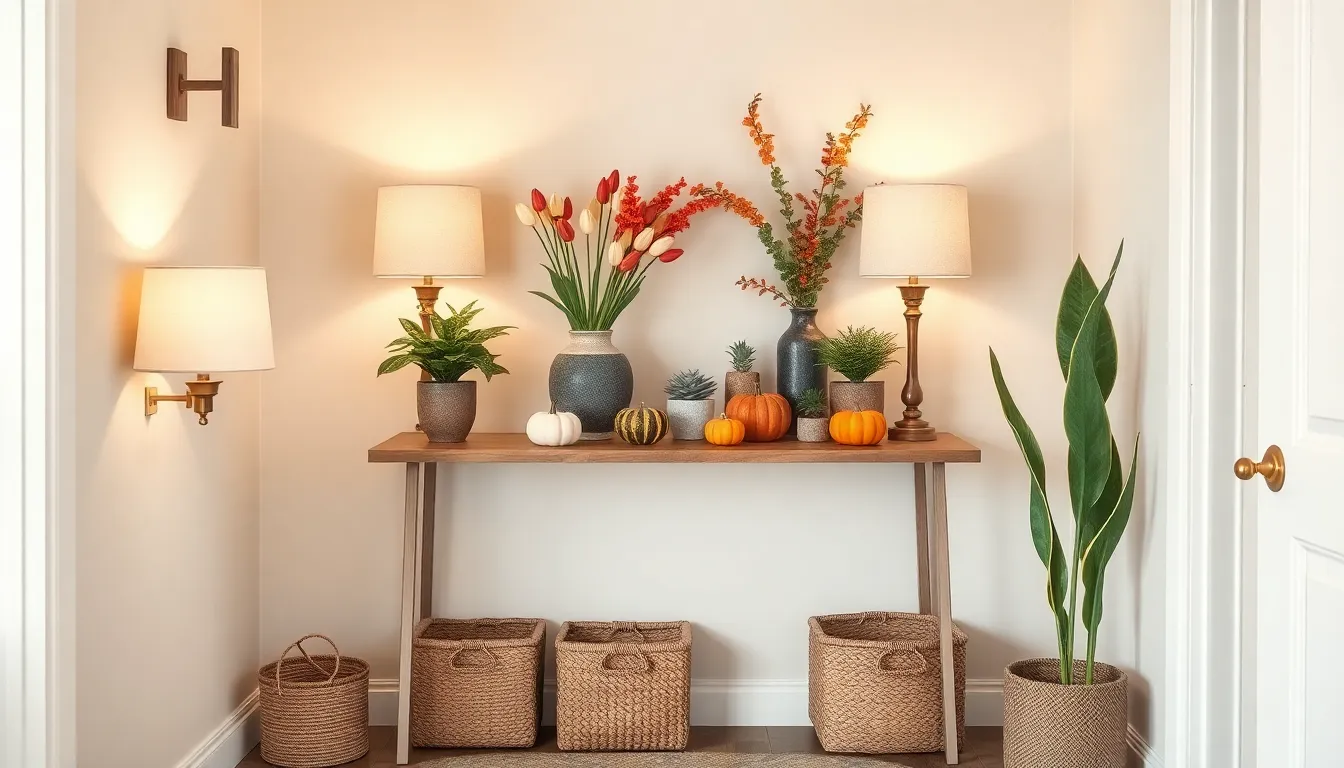
Creating a dedicated console table display area transforms your upstairs hallway into a purposeful design statement. We recommend positioning a narrow console table against the longest wall to maximize visual impact without impeding traffic flow.
Style With Seasonal Decorations And Plants
Seasonal decorations keep your upstairs hallway feeling fresh and connected to the changing calendar. We suggest rotating displays every few months to reflect holidays, seasons, or family milestones. Spring arrangements might feature fresh tulips in ceramic vases, while autumn displays could showcase miniature pumpkins and warm-toned candles.
Plants bring natural life to your console table display area and improve air quality throughout the space. Potted succulents require minimal maintenance and thrive in varying light conditions. Snake plants work exceptionally well for hallways with limited natural light, while trailing pothos can cascade elegantly from taller console tables.
Living elements create visual interest and serve as conversation starters when guests visit your home. We recommend choosing plants that complement your existing color scheme and require similar care routines for easier maintenance.
Add Table Lamps For Task Lighting
Table lamps provide essential task lighting while creating a warm, welcoming atmosphere in your upstairs hallway. We suggest selecting lamps with unique bases or interesting shade materials to add personality to the space. Ceramic table lamps offer durability and come in countless colors and patterns to match your decor style.
Brass or bronze fixtures add sophistication and work well with both traditional and modern console table arrangements. We recommend choosing lamps that are proportional to your console table width, typically selecting fixtures that are 24 to 27 inches tall for standard height tables.
Strategic lamp placement creates ambient lighting that makes your hallway feel more inviting during evening hours. Multiple small lamps distributed along longer console tables provide better light distribution than single large fixtures.
Include Baskets For Convenient Storage
Baskets underneath your console table offer practical storage answers while maintaining the area’s aesthetic appeal. We recommend selecting woven containers that complement your hallway’s color palette and style preferences. Natural fiber baskets like seagrass or rattan add texture and warmth to the space.
Storage baskets can hold seasonal items like gloves, scarves, and hats during winter months, then transition to storing beach towels or outdoor gear in summer. We suggest labeling baskets discretely or choosing different sizes to designate exact storage purposes.
Convenient storage answers help maintain organization throughout your home’s high traffic areas. Multiple smaller baskets work better than single large containers because they allow for better categorization of stored items and easier access to frequently needed objects.
Conclusion
We’ve shown you that upstairs hallways don’t have to be forgotten afterthoughts in your home design. With the right combination of lighting statement pieces storage answers and decorative elements these transitional spaces can become some of the most memorable areas in your house.
The beauty lies in how these design strategies work together. Your gallery wall pairs perfectly with strategic lighting while your runner complements the architectural details you’ve added. Each element builds upon the others to create a cohesive and welcoming space.
Remember that transforming your upstairs hallway doesn’t require a complete renovation. Start with one or two ideas that resonate with your style and budget then gradually layer in additional elements as you discover what works best for your exact space and family’s needs.
Frequently Asked Questions
What are some budget-friendly ways to transform an upstairs hallway?
You can transform your upstairs hallway without breaking the bank by creating gallery walls with family photos, adding statement lighting like wall sconces, incorporating a colorful runner rug, or applying bold wallpaper to create visual interest. These simple changes can dramatically enhance the space’s appeal.
How do I create an effective gallery wall in a narrow hallway?
Choose a cohesive color palette for frames to maintain visual harmony, then mix different frame sizes for added interest. Include personal mementos and travel souvenirs to make it uniquely yours. Rotate displayed items seasonally to keep the gallery fresh and reflective of family milestones.
What type of lighting works best for upstairs hallways?
For high ceilings, dramatic chandeliers add luxury and sophistication. Wall sconces provide ambient lighting and warmth, while pendant lights offer modern appeal. Consider multiple fixtures to create rhythm in longer corridors, and ensure proper proportionality for maximum visual impact.
How can I add storage to my upstairs hallway without cluttering the space?
Install built-in solutions like custom cabinetry that fits into alcoves or corners for concealed storage. Floating shelves display decorative items while keeping practical items accessible. Window seats with hidden storage create inviting spaces while maximizing functionality and maintaining a clean appearance.
What colors and patterns work well in upstairs hallways?
Geometric patterns create visual movement and make narrow spaces appear wider. Dark colors provide an intimate, luxurious atmosphere that showcases artwork beautifully. Textured wallpaper adds depth and interest. Choose patterns that complement your home’s overall style for cohesive design.
How do I choose the right rug for my upstairs hallway?
Select durable materials like wool, sisal, or synthetic fibers for high-traffic areas. Choose patterns that complement your home’s style – bold geometric designs for contemporary spaces or classic motifs for traditional homes. Consider layering rugs to create visual depth and define zones.
Can I add seating to my upstairs hallway?
Yes! Place benches under windows to create reading nooks with natural light. Choose cushioned benches with storage for practicality. Built-in window seats maximize space and provide hidden storage, while vintage chairs add character and warmth to the hallway area.
What architectural details can enhance an upstairs hallway?
Add wainscoting for classic elegance and wall protection. Crown molding provides a polished transition between walls and ceilings. Board and batten installation adds rustic charm and farmhouse character. These details transform ordinary hallways into sophisticated design statements.
How can I style a console table in my upstairs hallway?
Position a narrow console table against the longest wall and style it with seasonal decorations and plants. Add table lamps for warm task lighting and use baskets underneath for practical storage. This creates a purposeful design statement while maintaining organization.











